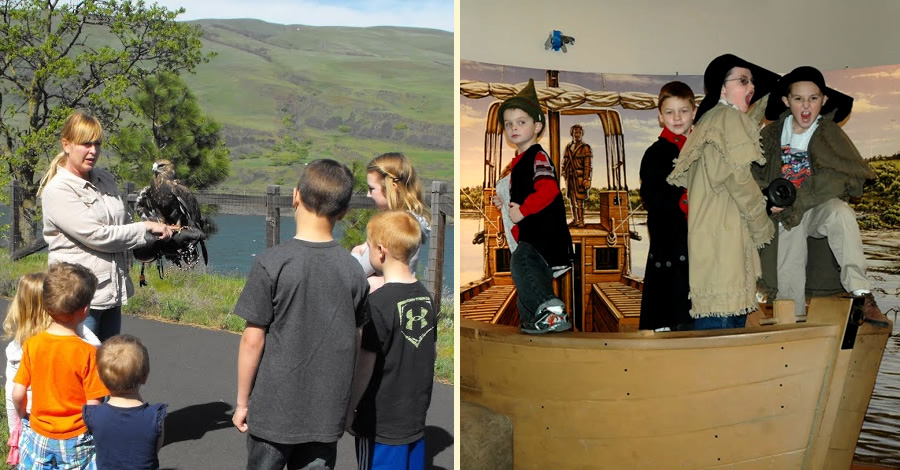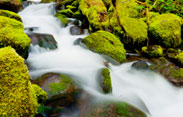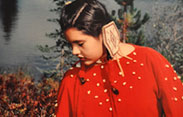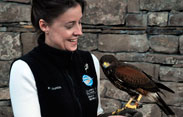
Experience Our Museum Classroom
Our museum programs integrate classroom-based interactive learning with museum exhibits. Most programs begin with interactive power-point presentations that use visual (digital photographs, diagrams, & maps) and physical (museum artifacts) information to enhance student understanding. Each program is then paired with guided interactions with museum exhibits or interactive games that further illustrate the material.
 Guided Tours for Schools and Large Groups
Guided Tours for Schools and Large Groups
Museum educators, volunteers, student interns, and USDA Forest Service Interpreters are available with an advanced reservation to lead one of seven activities using exhibits to encourage student participation and critical thinking. Plan up to an hour to fully participate in the activities.
For more information, see Planning a Tour.
 Columbia River Salmon Life History & Management
Columbia River Salmon Life History & Management
Tour Details:
In this interactive program students will simulate the journey of a salmon down the Columbia River to the Pacific Ocean and back. Along their journey students will encounter the hazards that salmon face. Through participatory discussion, students will gain an understanding of the challenges and opportunities of maintaining the Columbia River salmon fishery.
 Skills & Cargo of Lewis & Clark
Skills & Cargo of Lewis & Clark
Tour Details:
This program first familiarizes students with the Lewis & Clark expedition before asking them to question what skills might be required for the Corps members to be successful on their journey as well as what they would need to take with them. Students and the instructor then explore the skills of various members of the expedition that contributed to its success as well as technology of the time by examining specific equipment and supplies that the Corps of Discovery used over 200 years ago. Topics include medicine, scientific instruments, goods intended for trade with indigenous tribes, camping equipment, arms, clothing, and transportation.
 Lewis & Clark Landscape Ecology
Lewis & Clark Landscape Ecology
Tour Details:
This program explores the intersection of the landscape ecology of the Columbia River Gorge with the Corps of Discovery’s journey over 200 years ago. It examines how geological processes laid the foundation for the diverse ecosystems of the Gorge, and the resulting resources the Corps of Discovery utilized for food and trade as well as the challenges it faced in navigating through the Gorge’s inclement terrain and weather. As they learn the geologic and ecological story of the landscape from Celilo Falls to Beacon Rock and read the journal writings left by the expedition participants, students will gain appreciation for both the power of nature and the fortitude of the Lewis & Clark Expedition.
 The Oregon Trail: Decision at The Dalles
The Oregon Trail: Decision at The Dalles
Tour Details:
In this interactive program students will have to decide on two final routes to get to Oregon City – the official “end” of the Oregon Trail. They will become members of a wagon train that has reached The Dalles, Oregon. Students will become familiar with the challenges of the journey and the types of items that families needed to take with them to survive in the Oregon Territory. Some will decide to float down the wild Columbia River on rafts, while others finish the trek along the Barlow Road. Along the way they will face many hazards. After going both ways, students will determine which route would have been better for their wagon train.
 Early Inhabitants of the Columbia Gorge
Early Inhabitants of the Columbia Gorge
Tour Details:
Students will engage with the history and culture of the native people who have occupied the mid-Columbia region for at least 10,000 years through a presentation with artifacts and photographs.
 Raptor Discovery
Raptor Discovery
Tour Details:
Our trained raptor handlers and interpreters will introduce students to several raptors, or “birds of prey”, from our collection of non-releasable live animals. The birds may include owls, hawks, and falcons. Students will observe these live specimens and learn about the different types of raptors, what classifies them as a raptor, and their various life history strategies and adaptations to habitats.
For outreach availability and pricing, call 541.296.8600, ext. 240.
